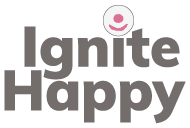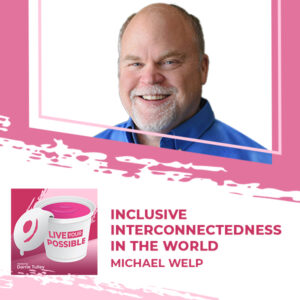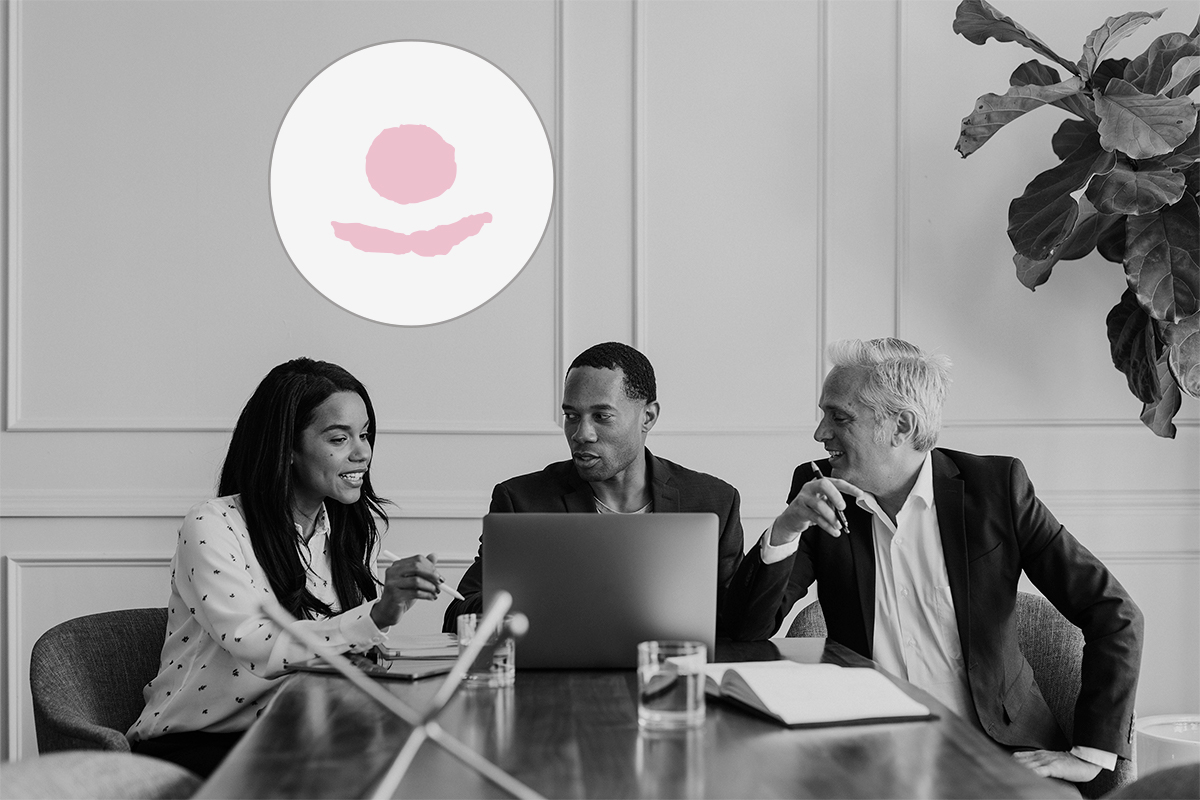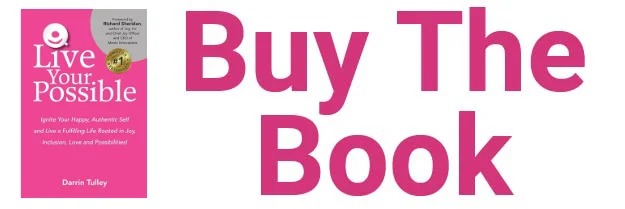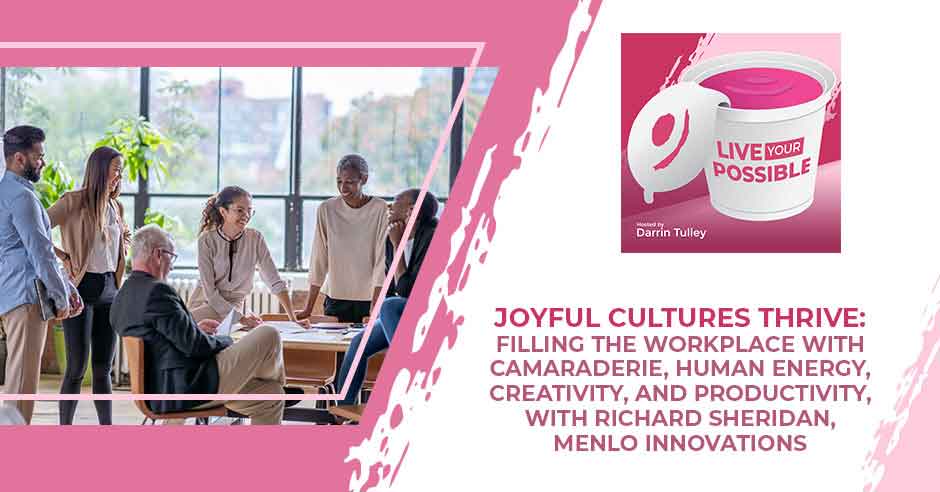
Why couldn’t a workplace be filled with camaraderie, human energy, creativity, and productivity? Why don’t we build joyful cultures instead of making our employees suffer from alienation and disengagement? Menlo Innovations CEO Richard Sheridan became disillusioned in the middle of his career in the chaotic technology industry. This frustration led him to become passionate about creating joyful cultures where people can thrive. He is now the co-founder, CEO, Chief Storyteller, and Tour Guide at Menlo Innovations. He’s also the author of Joy, Inc. and Chief Joy Officer. Join in as he shares with us how to bring joy and love into all of our workplaces and our communities, and our families.
—
Watch the episode here
Listen to the podcast here
Joyful Cultures Thrive: Filling The Workplace With Camaraderie, Human Energy, Creativity, And Productivity, With Richard Sheridan, Menlo Innovations
I’m excited to welcome our guest, Richard Sheridan. He’s the Cofounder, CEO, Chief Storyteller, and Tour Guide at Menlo Innovations. He’s also the author of two of my favorite books: Joy, Inc. and Chief Joy Officer. Menlo Innovations CEO Richard Sheridan became disillusioned in the middle of his career in the chaotic technology industry. He had an all-consuming thought, “Things can be much better.” He had to find a way. “Why couldn’t a workplace be filled with camaraderie, human energy, creativity, and productivity?”
Ultimately, Rich co-founded Menlo Innovations in 2001 to end human suffering in the workplace. His unique approach to custom software creation is surprisingly different in that 3,000 people a year travel from around the world just to see how they do it. His passion for creating joyful work environments and cultures led to his bestselling and wildly celebrated books, Joy, Inc.: How We Built a Workplace People Love and Chief Joy Officer: How Great Leaders Elevate Human Energy and Eliminate Fear.
Join us as Rich shares his background. He also gets into his childhood memories where we both got goosebumps and chills about what he brought to life at Menlo Innovations, and where he found joy and love in what he does. Learn with us as he figures out how to share with the rest of the world, how to shift, how to run the experiment, and how to bring joy and love into all of our workplaces, our communities, and our families.
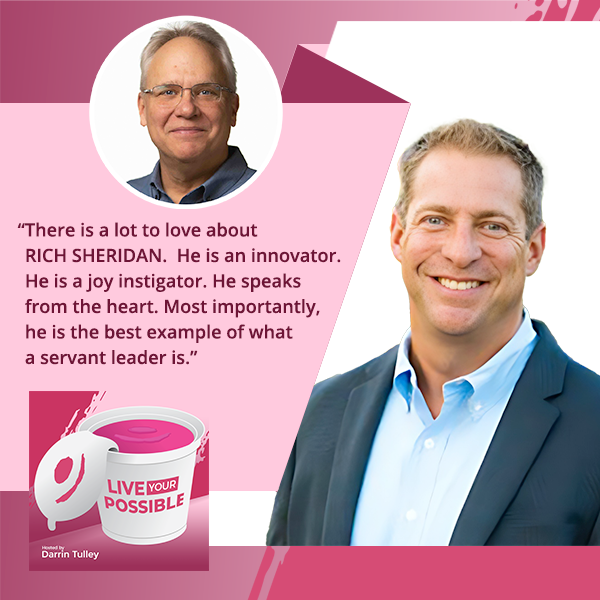
Welcome, Rich, to the show. I’m so excited that you’re here. I refer to you as so many things. You’re a great friend, a mentor, a partner, a believer, and a joy igniter. I think your reference is the joy guy. I’m so thankful for you and the Menlo Innovations team, all the Menlonians, to share what is possible with joy out in the world and what we could do in our workplaces together. I’m thankful and grateful for all of you. You’ve been doing this for over twenty years. You’re a pioneer. I’m interested to hear from you how things have changed over the last twenty years, how people are perceiving joy in the workplace, and what you’re coming up against these days.
I’m sure everybody has a story over the last three years of the pandemic. Things changed rapidly. They changed unexpectedly and we had to adapt to something that we would’ve never imagined in all of our years. You know us. We’re an intensely collaborative team working all shoulder to shoulder in the same office, pairing two people with one computer, switching the pairs every five days, sharing a keyboard and a mouse while they’re working together, designing, and building software on behalf of our clients. All that had to come to an end. It had to stop.
The way we had done things for our first nineteen years had to stop. We had to suddenly and dramatically shift as the rest of the world did. I am happy to say we did. It was a tough transition but fostered by the joyful culture we had built, the relationships, and the trust we had within our team. We then got hit with a 60% revenue drop in 2020. The pandemic wasn’t enough. Let’s take away 60% of the revenue. That made another mandate to not only adapt but survive. I’m happy to report we’re largely back in the office. About 80% of the team is back in every day. We had our best year ever in 2022. We climbed the mountain back up again.
There’s a need for joy in the world. That sounds pretty good. Welcome back. We need you all. You’re out there talking at various conferences and events around the world. You’re a storyteller. I’ve heard some people call you the voice of hope. What’s resonating out there? What’s resonating with people? People are turning their heads a little differently as far as joy or leadership. What are you noticing?
There have been a number of issues in corporate environments for a long time when employee disengagement has been stuck at 60% or 70% for decades, but in the last few years, there has been this great test of corporate cultures. Many of them have failed. They failed the test because their people started leaving or people started feeling a little more empowered about what kind of workplace should I look for. This idea of creating an intentionally joyful culture a few years ago felt like, “That would be so nice.” Now it’s imperative.
A few years ago, the idea of creating an intentionally joyful culture felt like something that would be nice to have. Now, it's imperative. Share on XThat’s incredible. It is imperative, especially coming through the pandemic, and how we’re caring for each other a little bit more. Humanity is back on the rise. Albeit, I think there’s a lot of opportunity. Hearing you talk about that, I remember when we met in 2017 at MassMutual. You were presenting in front of several hundred people. I was standing in the back of the room like, “Is everybody hearing this? We could talk about joy here?”
I’m sitting here saying, “There is nothing bad about the culture except we could do a lot better and we could do more things with joy.” I remember you came back to the room and I said, “Mr. Sheridan, I believe in what you’re saying. I would love to chat with you.” You’ve been so wonderful. You’ve been there with me this whole time since 2017. You’ve paid it forward. You’ve honored our friendship and your mentorship. Where did joy come to you? When did it happen? Did you fall in love with it? Was it always in you?
It’s funny how I get that question when I give talks and people ask me. When I first started answering, I started talking about the technological part of joy for me. When I touched a computer for the first time back in 1971, I was a kid in high school then. I fell in love with the idea of creating software. I thought, “That’s where the joy started for me.”
However, when I dug deeper, I realized, “That isn’t where it truly began.” I could identify a very clear moment or a story in my life when I was younger. When I was ten, my mom and dad bought a new shelving unit. New furniture wasn’t a common thing in our house. It was out in the garage in a box. It was like an IKEA thing we would send now. They went out to dinner and a movie. I was left on my own. For whatever reason, my brain went to, “I’m going to go build that shelving unit for them.”
I went out in the garage. I put this thing together. It was 8 feet wide and 6 feet tall. My ten-year-old kid was working with 50 pieces of wood and 200 little nuts bolts and screws. It wasn’t near as easy as IKEA is now. It then dawned on me, “Mom and dad wanted it in the living room and I built it in the garage.” I inched that thing out the front of the garage, down the sidewalk through the family room, the utility room, and the kitchen. I put it right in the living room where mom and dad wanted it. I set up dad’s books and mom’s knickknacks. I had the stereo playing mom’s favorite album.
When they came in and saw it, my mom cried. That moment, I think back now that it is the very definition of joy. It’s when the work of our hearts, our hands, and our minds is done for the delight of others. We ask at Menlo here two key questions about our purpose-driven culture. Who do we serve? What would delight look like for them? That for me is the very definition of who we are as people and how we are built as human beings. Our purpose on this planet is to delight others with our gifts and our talents.

Tying it back to when you’re ten. That’s sometimes some of our brightest moments. I have goosebumps. I recall reading that story in Chief Joy Officer and I think I cried. It was beautiful and it was touching. I hope you resonate with that one too because it’s shining through in everything you do. You’re an example of what servant leadership is all about.
Thank you for that. I have a theory about people who write books. I’ve done it twice now. I believe that if you cry while you’re writing a passage, your readers will cry when they read it. I cried when I wrote that part because it was a powerful memory for me. My parents have since passed and they were a wonderful influence in my life.
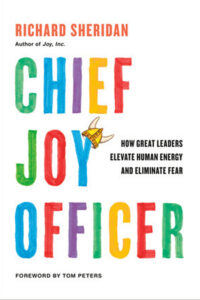
It shows true now. You’re carrying on the legacy. It gives me chills. It’s beautiful. How do you keep that lit? I’m so thankful and grateful for the foreword you wrote for my book. You talked about the life flame. How do you keep that lit within you?
You have to guard and protect it. That life flame can go out and it can stay out sometimes forever. There is a flame burning brightly inside of all of us, and it can be snuffed out, so be careful. When people ask me about this, number one, decide if this is a choice you make who you hang out with or what conversations you allow yourself to get pulled in with.
Number two, where are you getting fed? Where is your information coming from? I’ll give you an example of my life. I stopped watching the evening news in particular the local evening news, but even the national news 30 to 35 years ago. I don’t have my head buried in the sand. I still have newsfeeds. I keep up with everything. I usually score 11 out of 11 on the New York Times current events test they give every week.
I’m keeping up with things, but I’m not allowing the world to wear me down with what I call the murder, fire, and auto accident report that was followed by sports and weather. Be careful because what goes in can often be what comes back out again. I try and surround myself with positive people like you. I try and stay in touch with them. I try and read books that fill my head with bright and hopeful ideas about the future, but not be confused. It’s not optimism born out of anything but hopes, desires, and practical realities.
It’s so true about what we focus on. We can get more of it. We can manifest and we can create. Certainly having more of a positive outlook or optimistic outlook gives it a better chance. I’m guilty too. I stopped watching the news quite a long time ago. I even asked to be on the local news to try to lift up some positivity around thinking about joyfulness, happiness, and possibilities. They didn’t have time for me I supposed.
They will probably look at you like, “What planet do you live on?” Do bad things happen? Of course, they do but that’s not what happens on every street corner every day and in every aspect of our life. Part of it is, “What’s our spirit when we look at things? You can look outside here. We had this beautiful snowstorm and we got a foot of snow here. It created mayhem. There were fender bender accidents and we get to shovel off the driveway, the sidewalks, and all that stuff, or you can admire the beauty of it all. It’s a choice and I have chosen for a long time optimism. That’s a harder choice than pessimism.
Optimism is a harder choice than pessimism. Share on XIt takes effort because you’re going against the grain.
People hunt you down and say, “It didn’t turn out as good as you thought it would be. It’s like, “Yeah. At least, I tried.”
There is a lot of beauty in a snowstorm and the snow sitting on that tree. You can go out and do snow angels if you want, or you can go out and think about what is that doing to our society. It’s feeding us with water so it could give us growth and nurture ourselves and everything else. I noticed you’re in your new space. Congratulations on that.
I’ve been to Menlo several times. I can’t wait to get back out there. I would love to talk about the Menlo way and some of the experiences people are getting, and some of the tours pre-pandemic even virtually. Before we do, I was wondering if you could explain a little bit about the name Menlo Innovations and where it came from. I remember a story that gave me goosebumps once.
When you’re going to name a company, you have to think, “What would be meaningful? Way back before Menlo existed, I was a VP of R&D at Interface Systems. I had created inside of that old public company almost a prototype for what Menlo would become. I did it with my now cofounder James Goebel. He was a consultant to me then. What we had created inside that old public company is something that looks a lot like Menlo does now.
When people would come and visit, they were taking tours even back then. IBM, Microsoft, Pfizer, and Compuware were all coming to see us. They wanted to see this crazy new environment we called the Java Factory back then. People asked me where I got the idea for this. I said, “This is very much the way Edison used to work in his Menlo Park, New Jersey Lab.”
I wasn’t a student at Edison. I wasn’t a historical student of the times and what he did. As a kid, I would go visit this Dearborn, Michigan rebuilding of the Menlo Park, New Jersey Lab of Thomas Edison. When Edison moved out of Menlo Park into West Orange for the next bigger version of his invention factories, the old building was fallen into disrepair.
Henry Ford told his friend Thomas Edison, “I’m going to move that building to Dearborn, Michigan, and build a historical park around it.” A fun side story, Edison wagged his finger because he was much older than Henry Ford. He said, “Over my dead body. That building is to remain on New Jersey soil.” Henry Ford kept his promise. He said, “I’ll keep it on New Jersey soil.” He sent rail cars, dug up the dirt under the building, took it to Dearborn, Michigan, dug a hole, put the New Jersey soil in, and built the building on top of the soil.
I grew up in southeast Michigan. Every kid in southeast Michigan would go visit this place called Greenfield Village where the centerpiece of this village is the recreation of Thomas Edison’s Menlo Park, New Jersey Lab. I got goosebumps every time I went into that facility. I don’t even know why. Everything about it, the openness, the obvious world-changing inventions that occurred there, the stories of the camaraderie, the human energy in that space as they were working to invent things, and the variety of projects they were working on. It all made my heart sing like a kid.
I zoom forward and I’m telling these stories about how the way we worked at Interface Systems was like Edison. People thought, “That’s cute. That’s clever. We didn’t know that,” but they didn’t ask a lot of questions. I zoom ahead and now we’re forming a new company that’s going to be based on all these principles. I thought, “Maybe we honor that Edison connection.” I decided to read a bunch of books on Edison and I was blown away. I felt like I was reading my story inside of that story.
I have gotten to know the world’s foremost experts on Thomas Edison. People like John Bowditch who was local here at the Ann Arbor Hands-On Museum, Paul Israel who runs the Edison Papers Project at Rutgers, and Bill Pretzer who went to the Smithsonian. I had them in the room once together and they were bringing Edison to life right in front of me. It was so cool, but they have confirmed that what we have created here captures the spirit of that Menlo Park, New Jersey Lab of Thomas Edison.
How special is that bringing that into life so you can relive that every day? The passage in one of your books is you’re lighting up the world and that is what you’re doing.
When people come here and they walk in, it is invariably true that the first word out of their mouth is, “Wow,” because they can feel the human energy of this space. What was so hard for me when the pandemic hit was the room went dark and quiet. We were spread out all over the place. I didn’t know how we would do and we did just fine. It was unnerving for a guy who so valued having this in-person workplace.
I’m sure there are thousands of people that have been through the doors there. I know my experience when I first got there was childlike. I looked in with awe saying, “This is real.” There’s joy and execution going on at once. These are real things. It’s not just joy. It’s not just a word. It’s living out the dreams and aspirations that the whole team is committing to together. I would love to hear a little bit about the Menlo way and the experience people get when they come to the office. Hopefully, you guys will be opening the doors more openly than just virtually down the road. I’m not sure where you are with that these days either.
We had two classes this week alone. People are coming back. We’re open for business and for visitors to come. You’re welcome anytime, as are your guests. Typically, in pre-pandemic years, we were hosting between 3,000 and 4,000 people a year who were coming to come to see us. The nice thing is we offer virtual tours as well now, which we had never done before. We learned how to do that during the pandemic, but I don’t think there’s anything quite like being in the room, being in the space, and interacting with the team.
In terms of some essential elements of the Menlo way that intrigue people, one thing is we work not too surprisingly. It’s not that unusual. We work in one big open room with no walls, no offices, no cubes, and no doors. My cofounder and I sit out in the room with everybody else. We’re at the same folding metal tables as the rest of the team. There’s no gifted C-Suite for the cofounders or anything like that.
We work in pairs. We work two to a computer, which is probably the first thing that blows people away in particular. You think about introverted programmers paired together. They are sharing a keyboard and mouse all day long. The pairs never last more than five days and then we switch them. There’s a little bit of a team square dance that’s going on here where we’re changing the partners throughout the course of long projects that we work on. The result of those pairings and the fact that the pairs are all in a room together sitting shoulder to shoulder with one another, not just their pairs but their fellow pair partners around the set of tables means there’s a lively active conversation about the work that we’re doing every minute of every day.
I’m stepping into this quiet conference room so I could have this call with you. I left that noisy environment and I was literally feeling it just before I came in here. I’m like, “This is it. This is Menlo. It’s that buzz and that palpable human energy of people doing real work together and solving problems together.
The visual artifacts we have around the room, we do a lot of paper-based visual management systems, which blows people away because we’re a software company. They’re surprised we like to plan on paper to assign work and that sort of thing. We give people a chance to get meaningful things done at work. One thing at a time, we work on it until it’s done.
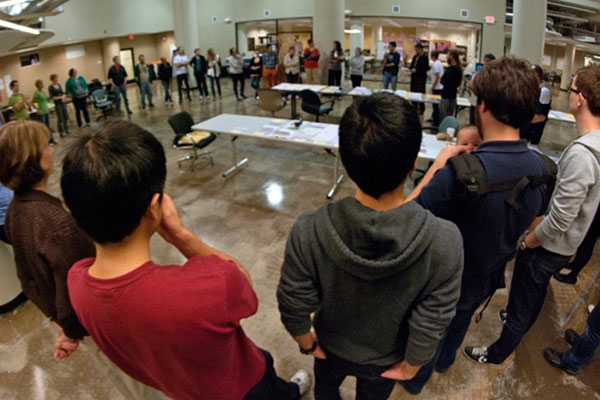
When I was there the first time, I saw some customers coming in and retelling the team what was done and what was working well. They are living it and it’s something that I value. I think it’s called the High-Tech Anthropologists. They are getting into the nature of how people do their work and the mission that you’re trying to solve. It is pretty fascinating, and the visuals that you’re talking about are worth seeing onsite.
I love the stories that you share there and they’re real. They’re simple and they’re straightforward. We tend to not think about it enough in our day-to-day. The pairing to me is a phenomenal concept. We’re learning from each other. I know the philosophy at Menlo is around learning, inclusion, and thought with each other, inclusion in general, and holding each other accountable.
Those are amazing things. I got to experience that on my second visit. I came to one of your workshops. It’s probably my favorite workshop I’ve ever been to in my life. It’s called Lead with Joy. It was wonderful. I brought Nakia. Nakia brought me. We were a pair. I think she’s now a good friend of yours as well. I had to say, at that event, we got to bond. We got to share and listen in different ways. We got to learn what it meant to be joyful. We got to learn and self-reflect about how we impact each other and how we can impact the broader team back at MassMutual at the time.
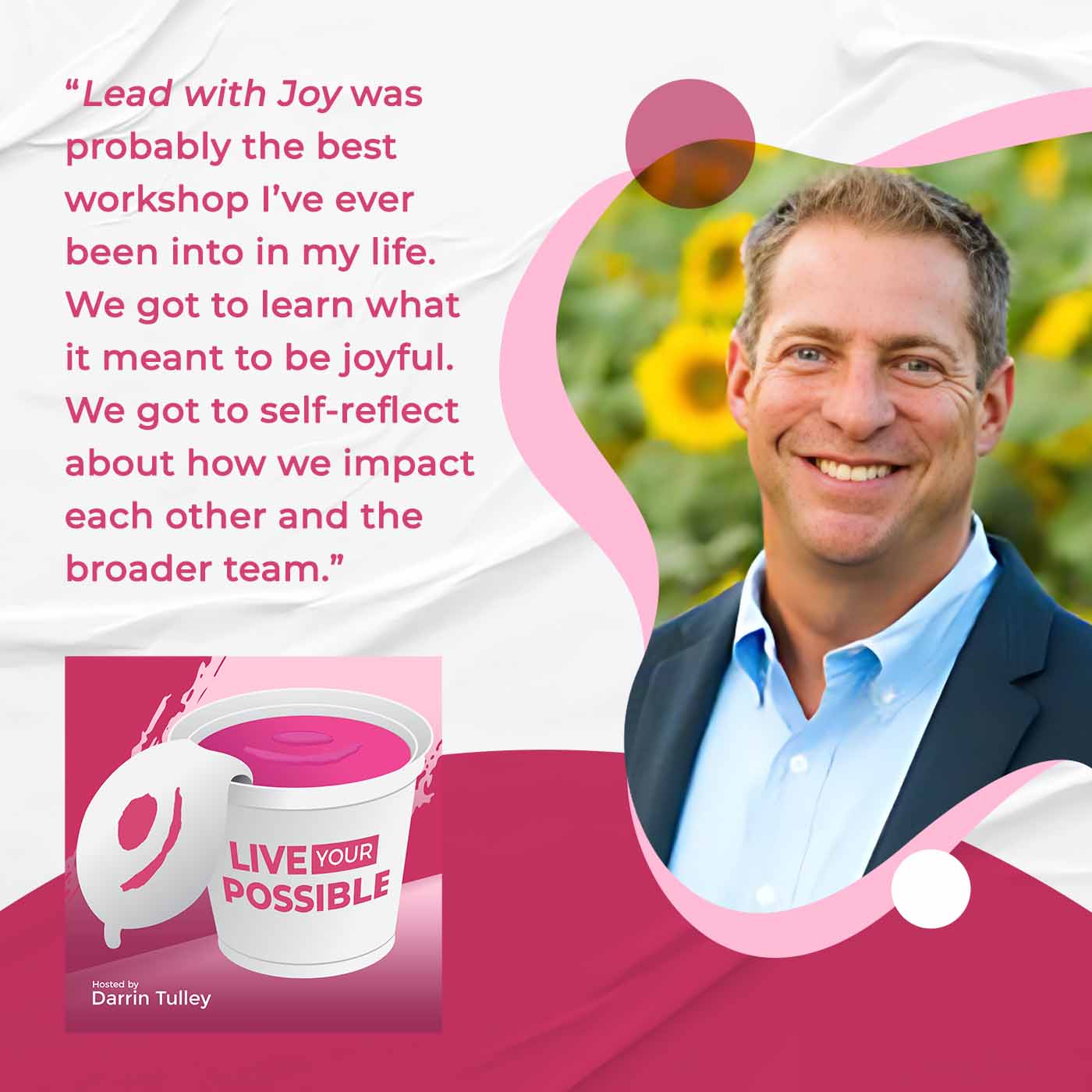
I had to say one of the things that were phenomenal from that event, you helped me figure out who I am as a person and as a leader. I remember crying at that event. I don’t mean to scare people away. It’s getting in touch with who we are as people. We went through the highest goal exercise and we got to the word possible. I connected with myself as I was a young child where I was always behind and I broke through. I became possible and I committed at that point that I was not only living my possible yet I was going to help others live theirs.
That was a big moment for me to shift how I was thinking about the world. I had to thank you because you put that in front of me to realize what is possible for me. The pairing concept allowed me to test that with Nakia and she challenged me and made it better. I have to say thank you again because I feel that was based on your book Chief Joy Officer and it related to that. I’m like, “What is a Chief Joy Officer? What are joyful leaders? How would you describe that?” I know there are elements of your book that goes through that. How would you describe that and how would you want the audience to think about what that means for them potentially?
While the title suggests like many C-level positions that you should have one, “A CJO is another member of the C-Suite.” I fundamentally believe that joyful leadership can occur in any person at any level. One of the chapters in the book talks about valuing leadership over hierarchical authority. Not that bosses are bad and leaders are good because you and I both have examples in our lives of good versions and bad versions of both of them. Leadership doesn’t need a title.
Leadership doesn’t need a promotion. Leadership doesn’t need a corner office or a place on a hierarchical org chart. You can lead from anywhere. That’s what we were trying to spark in that class. We wanted to spark the relationships that you talk about. It’s fun to hear you describe the two things that we were intentional about in the class. One is building relationships between people in the class. Particularly, those that came together as you and Nakia did.
Joyful leadership can occur in any person at any level. Leadership doesn't need a promotion. It doesn't need a corner office or a place on a hierarchical org chart. You can lead from anywhere. Share on XAlso, a joyful journey of self-discovery because for me, digging down into that authentic place in my heart from that ten-year-old story of delighting my mom and getting her to cry tears of joy because of something I had done for her. We all have those experiences hiding somewhere inside of us but the trouble is, we bury them away. We would call them unimportant. They don’t have a place in our work lives.
We should bring our authentic selves to work. There might be another place for those in our faith, lives, families, communities, schools, or something. That’s what people are looking for in their work lives. In many ways, the missing piece in the work lives is they leave their true self at home, and they bring a hallowed out version of themselves.
A joyful leader is one who can be humble and accept others as you did with Nakia. You accept that she could refine some idea you had, maybe even challenge you, or maybe even hold you accountable for it. We have to be open to those possibilities. Joyful leaders are optimistic. They choose what version of life am I going to look at.
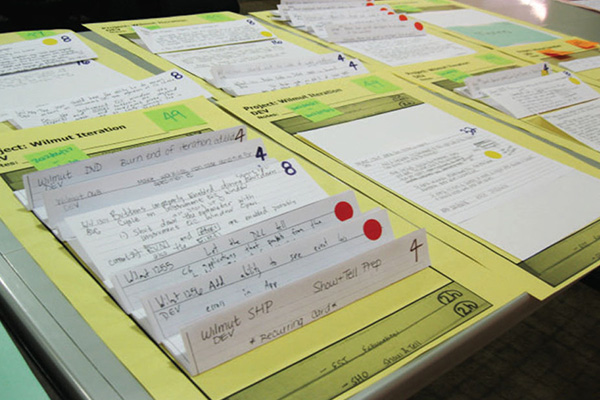
Am I going to spend all my time cascading down the fearful and scary route of all the things that could possibly go wrong or are we going to take a look at the optimistic side and contemplate the things that could go well, particularly, if I commit myself to help them go well? Joyful leaders are storytellers. Storytelling is what connects heart to mind, body to spirit, and concept to reality.
As Peter Drucker once famously stated, “Culture eats strategy for breakfast.” Storytelling sets the table for that meal. I will tell you one of the things we learned in the Lead with Joy class that you took was we better have boxes of Kleenex in there. I think you were there for the very first one and we blew it. We have all these people and tears are coming and noses are getting full and everything. We’re like, “We got to get some Kleenex and bring them in the room.” It’s because so many of us have kept such an important part of ourselves guarded and hidden away for so long. We’re afraid to break it out. That level of vulnerability that’s required to bring that part of our spirit out is hard.
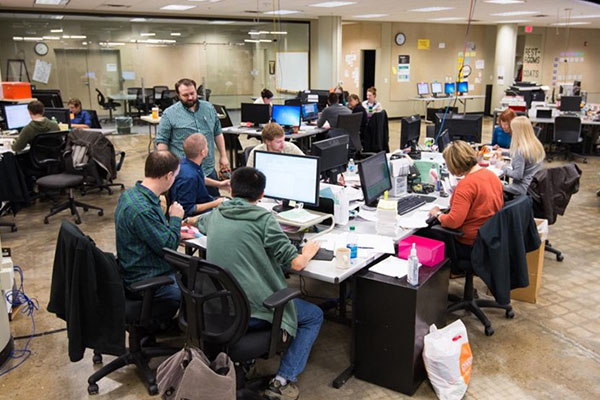
It takes courage and even acceptance of what does come out with the mindset that we’re going to grow and learn from it. I’ve had a few tears since my awakening and you’ve been a full part of that many times. The recognition that I could show that emotion now allows me to see all parts of emotion differently. I can accept joy and bring joy out too because I’m trying to hide all of it. As you said, hollow it out. It is a good way to describe it.
I was coming in robotic. I was coming in a bit uptight at work. I was coming in not my best self. I know some people would say, “You don’t want my full self.” It’s like, “Let’s check in on that a little bit too.” It’s so important because as the Chief Joy Officer and all the components that you said, the words joy and love are in both your books. You talk about loving as another aspect too. We could love each other at work and lead with love because it’s with heart and genuine care for one another.
That’s what I hear when I hear your story with your mom and your dad. You’re building as an engineer would like you’re doing now to show people what is possible. It’s fascinating and it takes courage to your point. We all do have examples of either ourselves or other leaders that we learn from in good and bad ways. You struck a nerve when you mentioned it to me because I had a boss that would say to me, “You got to be tough with people and you got to make people uncomfortable. You got to show them who the boss is.” I was like, “I want to use the honey approach, not the stinger.”
One of the things I talk about in the book is joyful leaders learn how to pump fear out of the room, not into the room. I don’t mean all fear is bad because there are some things we should be afraid of but what we don’t need to do is try and motivate people by creating artificial fear. Your boss telling you that you got to be tough on people. You got to make them feel bad and that’s how you’re going to get them. All that is going to do is shut down the most interesting part of our brains with adrenaline and cortisol. It’s going to turn off our creative mind, our inventive mind, and our innovative mind. Every company on the planet needs every ounce of creativity, imagination, and innovation we can get.
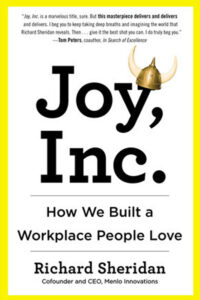
Imagination and wonder open up our minds to discovery, innovation, appreciation, and love. I’m looking at your tree again with the nice snow on it. All those things come back to that, and we do shut ourselves down. If we’re focusing on, “I got to have control and I’m going to run around and put the finger at people.” It’s going to put people in a different place. They’re going to work with a level of fear. Fear does not allow you to open your mind and be curious and wonder about all the beautiful things that you’re saying.
It’s not good for the person who’s delivering that.
I’ll be honest, a few years ago, I probably was leading with fear, and then I started to see things differently. I started to welcome differences. I started to accept that there was a better path. You showed up in my life and things changed. I kept getting better and continuously improving. The thing is on my third visit, I came back because there was the Positive Business Conference that you introduced me to with Bob Quinn and Jane Dutton, and the crew over at Ross Business School at the University of Michigan. It was an amazing place.
You talk about goosebumps walking into Menlo and Menlo Park as your example there. I felt the same way going to this conference. I felt like, “There’s a different light here. I feel like I belong.” There’s something special just like going into Menlo. When I went back into Menlo for the third time, what I also recognized is the beauty of your team continuously growing and improving. You invited me to have one of my first speaking engagements and to be part of the Lunch and Learn. Your team gave me feedback because that’s what you do.
You don’t have bosses, yet you provide feedback to each other to get better based on presentations, skills, effort, etc. You did that for me and I’m thankful. It was amazing. I learned a ton of great feedback. Essentially, what we did is we ran the experiment. One of my favorite things about you and Menlo is running experiments. I’d love for you to share with the audience what needs to be present for doing that very thing, running the experiment.
Somebody will get an idea from a book they read, a conference they attend, or maybe from this show. They go back to work the next day. They grab the first person they see who didn’t hear what they heard, didn’t read what they read, and didn’t see what they saw. They say, “I got a new idea.” They’re typically met with, “That’s against policy. That won’t work here. We tried that ten years ago, but it didn’t work then. It won’t work now.”
Right then and there, the idea dies on the vine because you’re busy. You don’t have time to fight this force wind that’s coming at you. What I encourage them to do is give them a canned response when that happens. I say, “Look them in the eye and say I get it, but let’s try it before we defeat it. Let’s run the experiment.”
The phrase itself changes people’s brains because they look and go, “Yeah, sure. It’s just an experiment.” The terminology itself pulls fear out of it because a lot of people say, “It’s an experiment. If it doesn’t work, that’s okay.” The key element of the experimentation mindset is, “We’re going to try stuff and some of it is going to work and some of it isn’t. We’re not going to get to wander around the axle if it doesn’t work because it was just an experiment and we are always trying stuff.”
I’m living proof of that and your team does it all the time. One of the things that you wrote about MassMutual is people came alive because they were allowed to run the experiment. People came up with creative ideas that improved the customer experience, the customer beneficiaries, and the livelihood of the actual employees. How about that? The people lit up. I saw it firsthand.
I did too. It was a great story. Amy Ferrero’s team at MassMutual occurred in as short as a six-month time period at a 180-year-old, $30-billion life insurance company. You can come to Menlo and say, “Rich, it’s an entrepreneurial venture. It’s young. It’s in the high-tech space.” It’s like, “No.” I’m going to tell you stories of Mike at McDonald’s. I’m going to tell you stories of MassMutual. I’m going to tell you stories from places where you’re like, “I’m not going to let you off the hook because this kind of stuff is not unique to Menlo.”
It’s still rare and that’s why the Positive Business Conference at Ross Business School is so cool. It’s this gathering of rare business thinkers, but none of us are unique. We all have something to contribute. We all have different ideas. When you start gathering those people together, what you get from that is permission to think differently because you’re like, “I’m not the only crazy one here.”
The last time I saw you was in March 2020. We all know that was the start of the pandemic and you were presenting. We had a two-day manager offsite. We were talking about culture and engagement, which is phenomenal. We got to that point and you talked about taking the fear out of the room and coaching with joy. We got these great postcards. I have mine. I was reading it earlier. It was about doing more experiments, being authentic, caring, and intentional, reducing fear, and making it safe for people.
It’s real and it was so timely too because it allowed us to realize what we needed to do when the pandemic hit because we all were scared. This is one of my last questions. I’m curious if there are any vulnerable moments maybe during the pandemic or maybe a light-up moment or click moment that you haven’t shared that you want to share that ties into all this beautiful work that you’re doing and the team is doing. Is there anything else you wanted to share?
I panicked when the pandemic hit because I thought I had witnessed the destruction of what we had created. We all went home. We couldn’t do our High-Tech Anthropology, which is about going out in the world and studying people in their native environment. We couldn’t have tour groups come in. I couldn’t get on airplanes to go speak about everything. It was such a dramatic shift for me.
My calendar emptied, and all the speaking engagements that I had planned were now gone. I have to admit, at that moment, I thought, “You accomplished what you set out to do. You couldn’t have anticipated this so don’t take it too hard. Don’t think you failed. This may be the end, but that’s okay. You succeeded.” I started watching the team remotely and it’s all still working. They’re still doing it.
One day, Molly, one of our Senior High-Tech Anthropologists was putting together an engagement that they were going to do virtually High-Tech Anthropology. It is literally about going out into the world and they’re going to do it via Zoom. I’m like, “There’s no way.” Molly leans in and says, “This will be so exciting to figure out how to do this.” I’m like, “Thank you, Molly. I need to hear that.”
The team rescued me. They didn’t think they had to, but I let them lead at that point. I watched them and they rebuilt Menlo in this virtual way and it was beautiful. I thought, “Wow.” The only input I gave the team at that point was very high level, “We’re going to get back to thriving again. I know we are. We’re going to take five steps to get there. Number one, we’re going to survive and that’s going to mean there’s going to be some tough things we’re going to have to do along the way. We’re going to adapt now and I see you doing that already. We’re going to sustain because we don’t know how long this is going to last. We are going to emerge stronger. That means we’re going to run a lot more experiments. We’re going to try things we’ve never tried before. If we consistently and regularly do those four things for as long as it takes, we will thrive again.”
At the end of 2022, we handed out the biggest bonus checks we’ve ever handed out in the company’s history because we rang every business bell we could ring. We were back to thriving again. It didn’t take as long as I thought it would. My lesson out of all of that was that we had built this strong cultural foundation that was unbeknownst to us, and we were preparing for this moment. Even though we didn’t know it was coming, and even though we couldn’t have anticipated what happened, we were fully prepared when it hit because of the culture we had created up to that point.
What a gift! Many leaders focus on results and you’ve changed the order. Focusing on people, putting this belief in a place where people picked each other up and now you’re thriving. I applaud you and the team. I have so much love and admiration for you and Menlo and all the Menlonians. I’m so honored to be a friend of yours. I’m not only a believer and also a cheerleader. Everybody should take advantage of that and just keep building their story so they can go live your possible. Rich, I am so thankful and I look forward to visiting you out in Ann Arbor soon.
I can’t wait to see you here, Darrin. Thank you for having me on your show.
—
That was amazing. Rich Sheridan, I love that man. I mentioned on the show how he pays it forward. He has given us a gift to think about every single day. It reminds me of Jim Gaffigan’s skit about the bonus fry. That bonus fry that’s on the bottom of that McDonald’s bag where you didn’t expect it to be there. You’re so excited because of that one more bite that you want because it’s so tasty. He goes on and says, “This is a gift. You might as well pay it forward.”
That’s what Rich is doing. He is giving us a gift to pay this forward. When you start to put this into action, think about the ways you could spark your life. You could be the lighthouse for other people so they could start to see the path of possibilities in front of them too. He’s so authentic and real. He’s an innovator, a joy instigator, and he speaks from the heart and the truth. The stories that he shares about his childhood and how he’s connected that to the way he lives now are phenomenal.
He even invited all of us to think about what are those childhood memories that are living inside of us that are maybe layered pretty deep inside us to allow us to bring that to life, in the workplace, at home, or even in our communities. Think about the things that we want. What do we want to focus on? What do we want to manifest? What are the actions we want to take?
Think about that for yourself. You’ll start to think about living your possible and igniting joyful possibilities all around you every single day. Join me for the next episode. Let’s continue to live our possible together, and spark amazing opportunities and livelihoods. Let’s change this world together one person at a time.
Important Links
- Menlo Innovations
- Richard Sheridan
- Joy, Inc.
- Chief Joy Officer
- Positive Business Conference
- High-Tech Anthropology
- https://MichiganRoss.umich.edu/faculty-research/areas-of-study/positive-business
- @MenlopPrez – Twitter
- @MenloInnovation – Twitter
- @MenloPrez – LinkedIn
- @Menlo-innovations – LinkedIn
- https://IgniteHappy.com/live-your-possible/
- https://ignitehappy.com/when-joy-meets-happy/
About Richard Sheridan
 CEO, Chief Storyteller & Tour Guide
CEO, Chief Storyteller & Tour Guide
Author of Joy, Inc. & Chief Joy Officer
Menlo Innovations CEO Rich Sheridan became disillusioned in the middle of his career in the chaotic technology industry. He had an all-consuming thought…things can be better. Much better. He had to find a way. Why couldn’t a workplace be filled with camaraderie, human energy, creativity, and productivity?
Ultimately, Rich co-founded Menlo Innovations in 2001 to end human suffering in the workplace. His unique approach to custom software creation is so surprisingly different, that 3,000 people a year travel from around the world just to see how they do it.
His passion for creating joyful work environments and cultures led to his bestselling and widely celebrated books, Joy, Inc. – How We Built a Workplace People Love and Chief Joy Officer – How Great Leaders Elevate Human Energy and Eliminate Fear.
